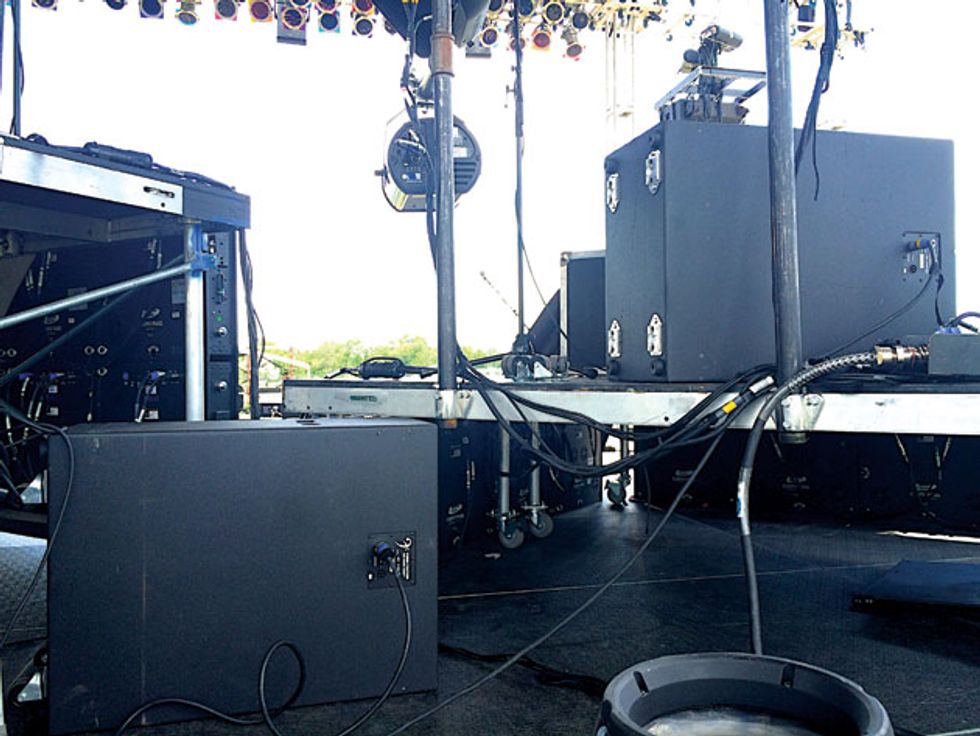The need to constantly feel the bass when performing live is a real struggle for us bassists. That’s why I regularly change cabinet sizes, configurations, and brands depending on what type of gig I’m playing. Of course you have to be able to hear yourself onstage, but at the same time balance that with how much stage volume your bandmates and front-of-house (FOH) engineer can live with.
In-ear monitors. Alternative solutions like in-ear monitors with extended low-frequency capabilities have continued to pop up over the last few years. These buds usually employ improved housings and multiple drivers in order to reproduce the low end of 5-string basses and kick drums at louder volumes. Even though the custom-fitted in-ear molds sound amazing and are the industry standard on most major tours, I prefer the generic buds that use a silicone slip-on cover. These buds move seamlessly with the movements of my jaw when I sing harmony or make bass faces, and do a better job of providing a solid low end with an almost airtight seal. Surprisingly, some generic buds are very inexpensive. I play stadium stages where I have to be up to 50 feet away from my fairly small bass rig with a set of $55 ear buds (Photo 1).
The biggest challenge with in-ear monitors is that they require greatengineering. You simply can’t get through a show with a pretty decent in-ear mix, though you can get through a show with a pretty dismal monitor-wedge mix. Poorly engineered bass tone in an in-ear mix will kill your passion for playing bass in one second.
“Shaker” plates or boards. When I first started my touring career about 15 years ago, some of the top touring drummers in Nashville were attaching a cone-less driver to the underside of their drum thrones so they could “feel” their kick drum when using in-ears. Bassists soon caught on and started attaching a driver to a wooden board that would vibrate under their feet. (This technology has since been refined by the German company TecAmp, and their product is called the Pleasure Board.) If you’re able to stand within an area that’s limited to a few square feet while playing, this is a great solution for battling with stage volume and the lack of sub-lows in ear buds. Given the way I perform, however, it’s not something I’m able to use.
Floor coupling. The difference between a cabinet placed on its wheels and a cabinet placed on its protective corner pieces (usually plastic or metal) is big. The difference between a cabinet on its wheels and a cabinet resting on its own wood is astounding! Think about it: If every possible square inch of a cabinet’s body is vibrating the floor, good things are going to happen. I got hip to this fairly late in my career, but now I’m a stickler for it.
I permanently removed the corner pieces from all my cabinets, and I have the crew remove the wheels every night before a show. It only requires 10 seconds of work with the quick-connect-and-release design of the caster wheels, yet it ensures I’ll feel more bass for an entire 90-minute show. If the shape of the cabinet is rectangular instead of square, I’ll lay the cabinet on its longer side to have more square inches touching the floor. On my current tour, my cabinets are in contact with both the stage floor and the riser so I can feel the bass at all times no matter where I’m located (Photo 2). Removing protective pieces and laying a cabinet on its side can be very hard on a Tolex or cloth cover, so I’m not able to keep my cabs in mint condition.
Photo 2
Speaker placement. If your FOH engineer is complaining about your stage volume, you might want to consider tilting your cabinet up toward your ears. You’ll hearthe bass twice as loud, but you’ll feelit less due to the floor coupling you sacrifice.
Another possible solution I recommend is side amping. Placing your cabinet on the side of the stage and facing it in toward the band essentially turns your rig into a large side-fill monitor. This can be very effective as long as your bandmates don’t mind hearing the bass as loud as you do. The technique has worked out really well for me, especially on the large concrete stages found in amphitheaters. Concrete does not vibrate much at all, so I compensate with lots of volume and side amping. I rarely have to use side amping when playing on older, wooden stages because they carry low end beautifully and allow me to use far less stage volume.
Speaker size. Over the years, 10" speakers have pretty much become the industry standard for bass guitar. One reason is their waveform may be easier to manipulate than larger-diameter speakers, and therefore can absolutely contribute to your FOH engineer having less problem with your stage volume.
Almost every night I make small changes to get maximum rumble with minimal negative effect on my engineers and fellow musicians. Never forget: No two stages or rooms react the same to your bass frequencies.









![Rig Rundown: AFI [2025]](https://www.premierguitar.com/media-library/youtube.jpg?id=62064741&width=1245&height=700&quality=70&coordinates=0%2C0%2C0%2C0)












 Shop Scott's Rig
Shop Scott's Rig




![Rig Rundown: Russian Circles’ Mike Sullivan [2025]](https://www.premierguitar.com/media-library/youtube.jpg?id=62303631&width=1245&height=700&quality=70&coordinates=0%2C0%2C0%2C0)










































